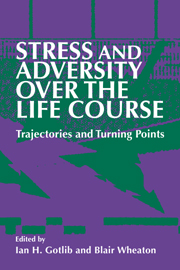Book contents
- Frontmatter
- Contents
- List of contributors
- 1 Trajectories and turning points over the life course: concepts and themes
- I Trajectories: long-term effects of adverse experience
- 2 Childhood adversity and adult psychopathology
- 3 The impact of twenty childhood and adult traumatic stressors on the risk of psychiatric disorder
- 4 Intergenerational sanction sequences and trajectories of street-crime amplification
- 5 School-leavers' self-esteem and unemployment: turning point or a station on a trajectory?
- 6 Intergenerational consequences of social stressors: effects of occupational and family conditions on young mothers and their children
- 7 Women's roles and resilience: trajectories of advantage or turning points?
- II Turning points: changes in life trajectories
- III New methods for the study of the life course
- Index
3 - The impact of twenty childhood and adult traumatic stressors on the risk of psychiatric disorder
from I - Trajectories: long-term effects of adverse experience
Published online by Cambridge University Press: 23 October 2009
- Frontmatter
- Contents
- List of contributors
- 1 Trajectories and turning points over the life course: concepts and themes
- I Trajectories: long-term effects of adverse experience
- 2 Childhood adversity and adult psychopathology
- 3 The impact of twenty childhood and adult traumatic stressors on the risk of psychiatric disorder
- 4 Intergenerational sanction sequences and trajectories of street-crime amplification
- 5 School-leavers' self-esteem and unemployment: turning point or a station on a trajectory?
- 6 Intergenerational consequences of social stressors: effects of occupational and family conditions on young mothers and their children
- 7 Women's roles and resilience: trajectories of advantage or turning points?
- II Turning points: changes in life trajectories
- III New methods for the study of the life course
- Index
Summary
Introduction
The word “stress” has come to have many connotations. Whereas research on life stress focused almost exclusively on life change events through the 1970s, research and theory since then have resulted in a differentiated stress universe, with multiple stress concepts (Wheaton 1994). Beyond life events, one can identify at least five other types of stressors, including chronic stressors (Pearlin 1989; Wheaton 1983), daily hassles (Kanner et al. 1981), macrosystem stressors such as economic downturns (Dooley & Catalano 1984); “nonevents,” that is, the non-occurrence of expected events (Gersten et al. 1974); as well as various forms of childhood and adult traumas, considered individually or collectively (Cadoret et al. 1990; Garmezy 1983; Kessler et al. 1995; Rutter & Quinton 1977; Terr 1991).
In Chapter 2 of this volume, Kessler and his colleagues explored their ongoing research program on childhood adversities. These childhood adversities overlap considerably with the traumatic stressors studied in this chapter. Both refer to serious, often overwhelming, stressful experiences. The term “adversity” clearly allows for both discrete traumatizing experiences and more chronically difficult life conditions. In this chapter, we consider both types of stressors.
The potential importance of traumatic events and situations for long-term mental health is hardly in doubt. Research attention to such traumas has been intense in recent years, especially for certain “core” traumas thought to be crucial in setting long-term trajectories of mental health problems.
- Type
- Chapter
- Information
- Stress and Adversity over the Life CourseTrajectories and Turning Points, pp. 50 - 72Publisher: Cambridge University PressPrint publication year: 1997
- 49
- Cited by



